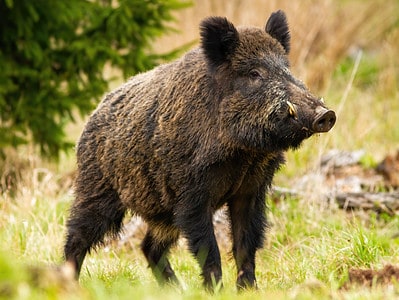Basilosaurus
Basilosaurus
Advertisement
Basilosaurus Scientific Classification
- Kingdom
- Animalia
- Phylum
- Chordata
- Class
- Mammalia
- Order
- Artiodactyla
- Family
- Basilosauridae
- Genus
- Basilosaurus
- Scientific Name
- Basilosaurus
Read our Complete Guide to Classification of Animals.
Basilosaurus Conservation Status
Basilosaurus Facts
- Diet
- Omnivore
Basilosaurus Physical Characteristics
View all of the Basilosaurus images!
If you thought that Tyrannosaurus Rex was the king of all prehistoric creatures, you may be surprised to hear of another reigning king that lived in the oceans. Basilosaurus, or the “king lizard,” was a prehistoric whale that dominated the sea. Weighing up to 10 tons, the Basilosaurus lived after the dinosaurs had gone extinct and mammals started to develop in greater numbers.
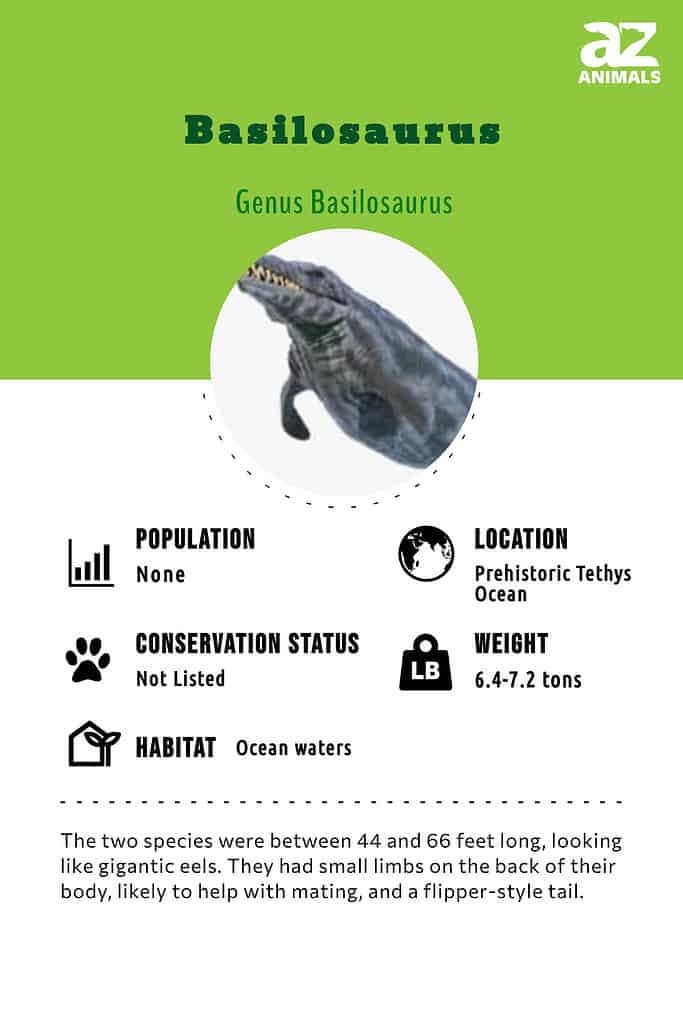
Scientific Name and Classification
The Basilosaurus was misnamed as a “saurus” because it was thought to be a lizard when a fossil was first discovered in the United States in 1834. However, it was a large, predatory, prehistoric whale from the Eocene period (41.3-33.9 million years ago). Other fossils have since been found in the Middle East, Pakistan, and Peru.
As a whale, it is a member of the Mammalia Class. Further, the Basilosaurus is from the Order Artiodactyla, the Infraorder Cetacea, the extinct Family Basilosauridae, the extinct Subfamily Basilosaurinae, and the extinct Genus Basilosaurus. There were two species: B. cetoides and B. isis which became extinct at the end of the Eocene period, probably because of some catastrophic planetary event.
Modern whales, dolphins, and porpoises are members of the Cetacea infraorder, although they diverge from Basilosaurus with their families. Basilosaurus belongs to the Artiodactyla order, along with other mammals with an even number of toes. While they did not have toes, they were descended from land creatures which is why they are included in that order.
Description and Size
Basilosaurus was large and in charge in the oceans. Of the two species members, Basilosaurus cetoides and Basilosaurus isis, both were between 44 and 66 feet long, although B. isis were often on the shorter end of that range. They were roughly the length of modern Humpback whales. The largest animal known to exist is the Blue Whale, which can be up to 100 feet long.
Basilosaurus whales were sleeker than many modern whales and looked almost like very, very large eels. They had small limbs on the back of their body, likely to help with mating. Basilosaurus had teeth that they used to eat food, rather than baleen like many modern whales of their size.
While they were quite large, these whales had small brains. Scientists believe that this shows that they were incapable of herd movement or even echolocation. They did have complex ear structures, although not all aspects were useful during their lives underwater. These whales had marrow-filled vertebra and bones, which helped them stay near the surface of the water as they swam.
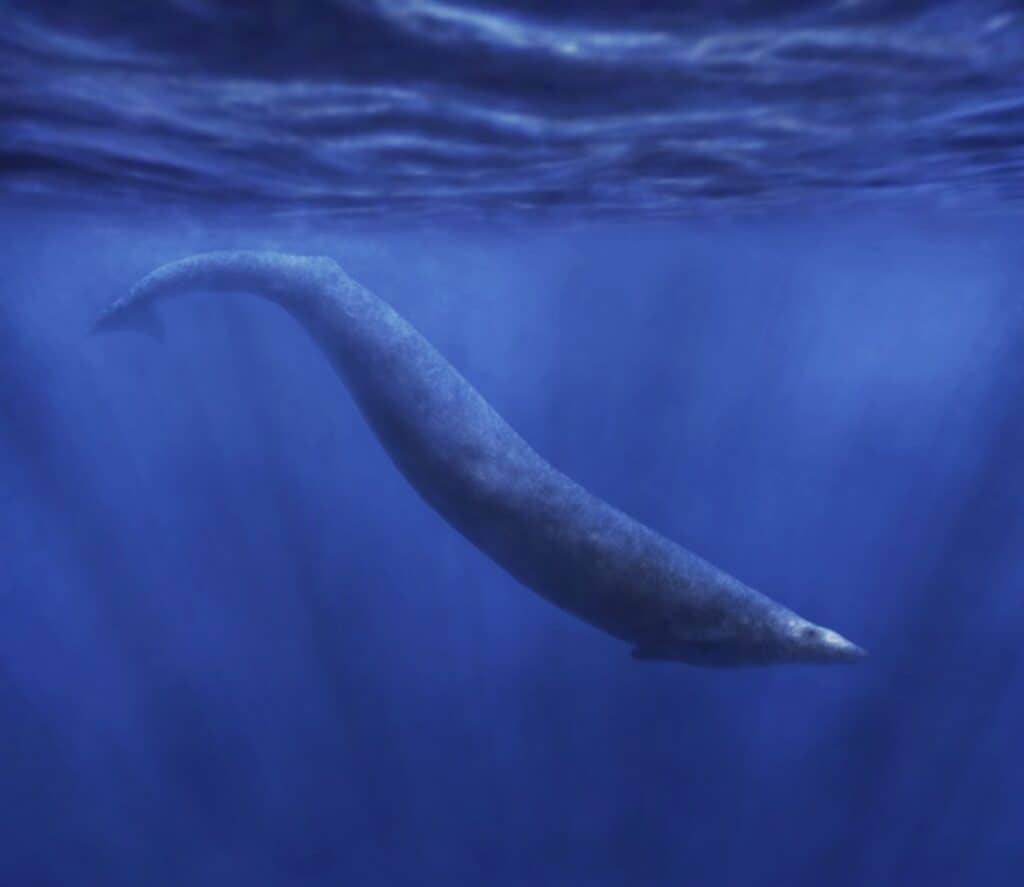
This picture is a reconstruction of the likely appearance of the Basilosaurus, a prehistoric whale, also known as the King Lizard.
©Dominik Hammelsbruch / CC BY-SA 4.0 – License
Diet
Basilosaurus had teeth, which can tell scientists a lot about their diet and how they lived. Their teeth show signs of wear. This indicates that basilosaurus chewed their food before eating it. They probably had to eat a lot to maintain their large size. Fortunately, there was no shortage of food sources for these hunters.
The two species, B. cetoides and B. isis, likely had different diets and preferences. B. cetoides remains have shown fish and sharks in their stomachs. Due to their large size and the presence of teeth, these whales were likely predators who hunted their food. B. isis exhibited the same behavior but probably favored Dorudon, an ancient sea mammal similar to a dolphin.
Discoveries of intact Basilosaurus skeletons help researchers know more about their diets. One full skeleton was found in Egypt that had other skeletons in the stomach. These include fish and dorudon. Sharks and prehistoric elephants that ventured near the water were also known prey for Basilosaurus. Because of their large size for the time and the type of teeth they had, it is likely that these ancient whales chewed meat and fish for most of their meals.
Habitat
These large whales evolved as sea mammals, similar to modern-day whales. Modern whales are not descended from Basilosaurus, however. They did experience a similar evolution, though.
These sea animals likely lived in the prehistoric Tethys Ocean. As landmasses shifted and moved, this area became the modern-day Indian Ocean and Atlantic Ocean. The presence of Basilosaurus fossils in Egypt, Northern Africa, Jordan, Tunisia, Morocco, and Pakistan show that they were common to this area when it was underwater.
Basilosaurus fossils are also common in the American South, especially in Alabama, Louisiana, and Mississippi.
Threats And Predators
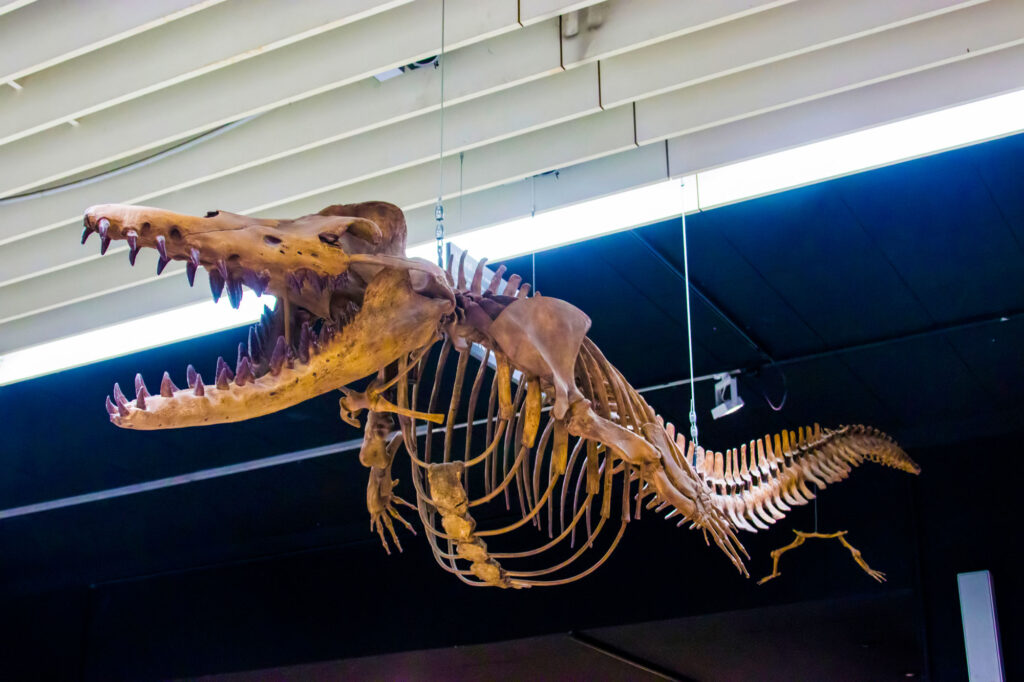
The skeleton of a Basilosaurus demonstrates the teeth and size that put it at the top of the food chain.
©Danny Ye/Shutterstock.com
Basilosaurus was at the top of their food chain in the water. They were large, carnivorous, and had the teeth to take down prey. Fish, sharks, dorudon, and even other whales were no match for the Basilosaurus. Even prehistoric elephants that lived in the area during the Eocene epoch could have been convenient food for Basilosaurus, if they got too close to the water.
Like any animal, injury and illness could have disastrous effects on Basilosaurus. Young and old whales were particularly vulnerable to any sort of impact. Changes in their food source could have also had a negative impact on the Basilosaurus population. Competition for food among these animals could have led to the weaker ones having a hard time surviving. Basilosaurus probably did not live in herds and vulnerable animals would have been prime targets for other predators or for starvation.
Discoveries and Fossils
The larger of the Basilosaurus species, B. cetoides, was discovered in Louisiana and Alabama. Researchers discovered fossils of this giant whale and eventually brought vertebrae and teeth to the UK for identification and comparison to other similar specimens. The key aspect that differentiated these fossils from others, other than their size, was the type of teeth. Scientists realized that the animal was a mammal that lived in the ocean.
Besides the discoveries in the southern United States, another key discovery occurred in Wadi El Hitan in Egypt. This massive sandstone formation contained so many whale fossils and skeletons that it became known as the “Valley of the Whales.” Included in this collection are Basilosaurus specimens. A key discovery in 2016 of a complete Basilosaurus skeleton at Wadi El Hitan taught researchers a lot about its structure and life. Skeletons of its prey were also found in the stomach. These included dorudon and fish skeletons.
One man sought to dazzle the public (and make some money for himself) with the discovery of a sea monster, which he called Hydrarchos. This specimen was actually a collection of Basilosaurus and other bones that he reassembled to make it look like a sea monster. Scientists noted that the teeth and bones were all of different ages and time periods. This made even the general public realize that his discovery was actually a scam.
Extinction
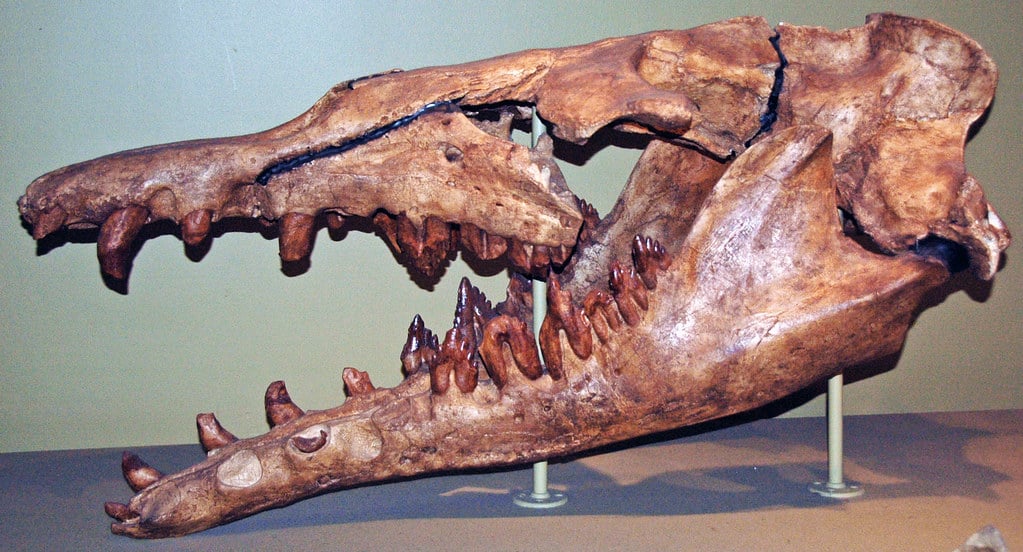
The Basilosaurus had a biting force of roughly 2,300 pounds, but it became extinct at the end of the Eocene epoch.
©
The oldest evidence of the Basilosaurus dates to around 33.9 million years ago. A large-scale event that heralded the end of the Eocene epoch likely impacted the Basilosaurus, like many of the other species that went extinct during that time period.
This extinction event may have been something significant like a meteor, based on evidence of impact zones. Other hypotheses point to gradual cooling that changed the available food sources for all animals, which eventually led to the extinction of many species, including Basilosaurus.
Popular Culture
The Basilosaurus is the state fossil of Alabama and Mississippi.
Before much was known about these ancient animals, many communities in the American South used their large vertebrae for furniture in the 19th century. What a conversation piece!
This creature is even mentioned in Herman Melville’s classic novel Moby Dick. According to Ishmael, the Basilosaurus fossils could be whale fossils.
Similar Animals
Similar ancient and modern animals to the Basilosaurus include:
- Dorudon: These dolphin-like sea mammals were smaller than the Basilosaurus. They lived at the same time and were actually one of the favorite foods for the predatory Basilosaurus.
- Llanocetus: Closer in size to the Basilosaurus, these creatures more closely resemble many modern-day whales. They had smaller teeth that act like baleen.
- Blue Whales: These modern whales are the largest species of whale to ever exist. For their immense size, they actually feed on tiny krill rather than other sea mammals.
- Humpback Whales: Another modern whale, these are the closest in size to the prehistoric Basilosaurus. They are descended from a completely different species, however.
Basilosaurus FAQs (Frequently Asked Questions)
When was the Basilosaurus Alive?
Basilosaurus lived during the late Eocene epoch, which ended 33.9 million years ago. It is likely that these animals went extinct due to environment cooling which impacted the entire eco-system and their food sources.
How Big was the Basilosaurus?
Basilosaurus measured between 44 and 66 feet long, similar to modern Humpback whales. They were large for the time period, however, and often the largest and most formidable predator in their environment.
Is Basilosaurus a dinosaur?
While they are prehistoric animals, Basilosaurus is not a dinosaur. Due to its tooth structure, scientists classify Basilosaurus as a mammal rather than a dinosaur or reptile. It has gone through different classifications since scientists first discovered it. In fact, its name Basilosaurus incorrectly identified it as a reptile at first. After researchers learned that it was actually a mammal, it continued to be known as Basilosaurus due to conventions of scientific naming that had it remain under its first name.
Is Basilosaurus related to whales?
Basilosaurus is an ancient whale. Basilosaurus refers to a genus within the Cetacea infraorder that includes modern whales, dolphins, and porpoises.
Thank you for reading! Have some feedback for us? Contact the AZ Animals editorial team.
Sources
- Thought Co., Available here: https://www.thoughtco.com/facts-about-basilosaurus-king-lizard-whale-1093325
- IUCN News Source, Available here: https://www.iucn.org/content/first-intact-fossil-prehistoric-whale-discovered-wadi-al-hitan
- Encyclopedia of Alabama, Available here: http://encyclopediaofalabama.org/article/h-1386
- PBS Eocene Epoch, Available here: https://www.pbs.org/wgbh/evolution/change/deeptime/eocene.html
- Smithsonian Evolution of Whales, Available here: https://ocean.si.edu/through-time/ancient-seas/evolution-whales-animation











